Apple iPhone 11 Pro and Pro Max review: Better, but not groundbreaking
But are they the right iPhones for you?
What does it mean for a phone to earn the name "Pro"? Lots of power, for one. Usually great cameras. And software robust enough to handle arduous tasks with ease. The new iPhone 11 Pro and Pro Max certainly tick all these boxes, and — as you might expect — they're the best iPhones Apple has ever made. The thing is, I say that every year and it's true each time, but it doesn't really sum up how I feel about the new iPhone Pros after having tested them for a while.
These are both excellent devices, and represent Apple at the peak of its smartphone game. But are they dramatically better than the premium phones the company gave us last year? Well, yes and no. There are plenty of additions and improvements here, but when it comes to day-to-day use, their impact on the overall iPhone experience can seem muted. Ultimately, I have my own theory about why these phones get the "Pro" moniker: Because some of the changes here are so subtle that it would take a pro to notice them, much less appreciate them.
Configurations
If you're considering buying one of Apple's new iPhone Pros, you have a few options (all of which are expensive). Each version of the iPhone Pro uses the same A13 Bionic chipset, packs the same set of cameras and comes in the same four colors: space gray, midnight green, gold and silver. As usual, your decision boils down to how big a phone you want and how much storage you think you'll need:
iPhone 11 Pro: 64GB ($999), 256GB ($1,149), 512GB ($1,349)
iPhone 11 Pro Max: 64GB ($1,099), 256GB ($1249), 512GB ($1,449)
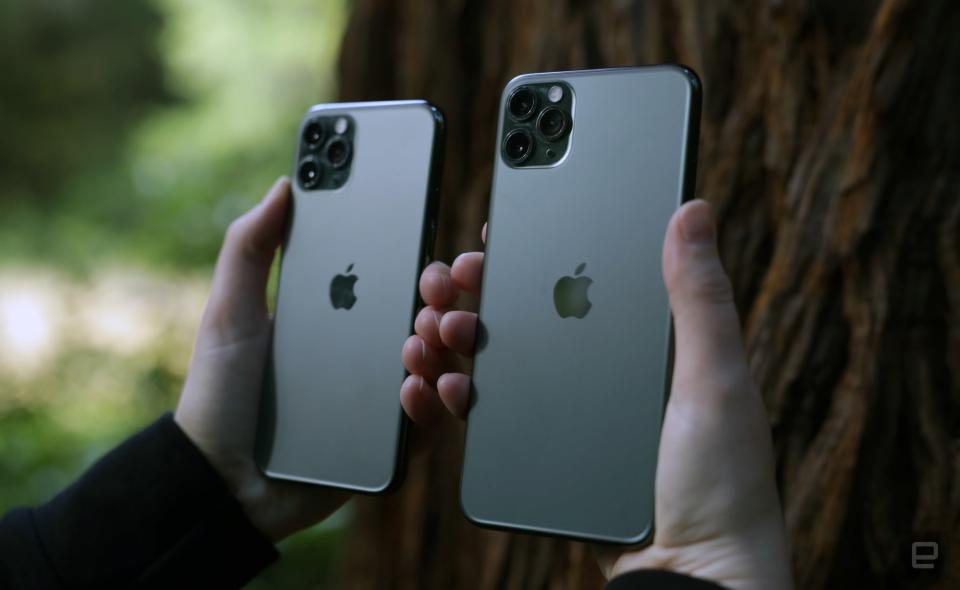
A new (but also old) design
Every few years, Apple totally rewrites the book on iPhone design. The transition from the 3GS to the 4 saw the company embracing a more angular aesthetic that I still miss, while the move from the 5S to the 6 marked a return to a friendlier, rounder look. This year's shift isn't quite as dramatic, but there are still plenty of changes to discuss.
For one, these new Pros are slightly thicker than the models they replace, though I don't think many of you would notice. (They're both marginally thinner than the iPhone 11, in case you were curious.) Apple also added a new color variant this time around: midnight green. As you've probably noticed in these photos, though, it might be more appropriate to call it "sort-of green." Under some bright (but indirect) light, the Pro and Pro Max have a subtle olive tinge. Anywhere else, the finish looks more like a slate gray -- that's not a bad thing, but it made photographing the thing a nightmare.
Apart from the colors, the biggest changes can be found on the Pros' backs. They're now clad in a single piece of milled glass with a matte finish that covers everything except the Apple logo and the phones' three cameras. I'm a fan of this design for a few reasons: For one, it gives the Pro and Pro Max a more distinctive feel compared with the mid-range iPhone 11. They're much less likely to show off greasy fingerprints, which -- as a slob -- I'm very grateful for. Apple also suggests that this new finish makes the Pros less prone to slippage, and that seems to be true. (Throwing on one of Apple's new clear cases wouldn't hurt, though.)
I'm the sort of person who doesn't think twice about leaving my phones perched precariously on uneven tables and the arms of couches. Needless to say, my things clatter to the ground a lot. It's hardly a scientific observation, but neither of the new Pros slid around as much as my iPhone XS typically does.
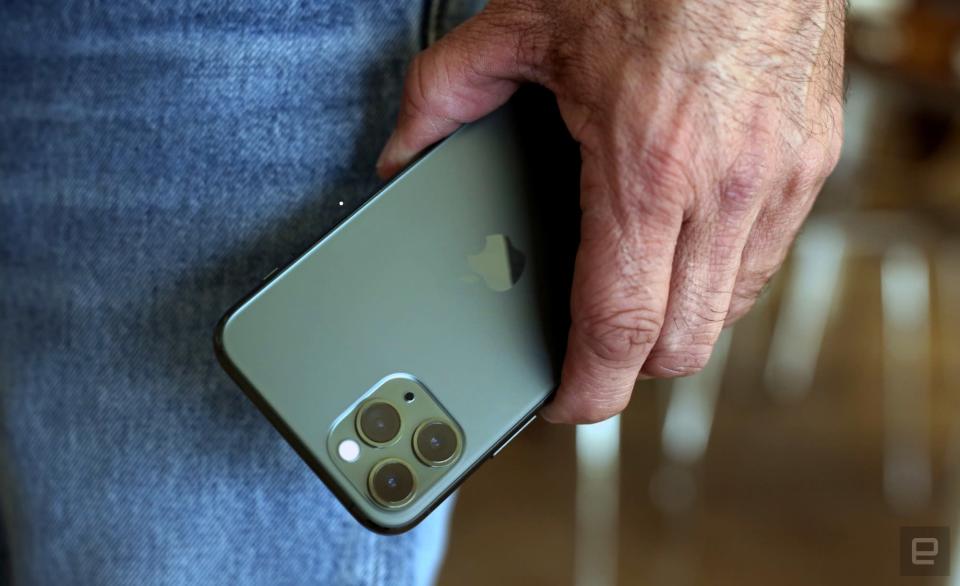
Apple also says that it used the "most durable glass in a smartphone" when building the Pros, which is a hard claim to test without deliberately trying to ruin hardware I don't own. I will say, though, I have dropped the Pro and Pro Max a few times onto our hard office floor out of sheer clumsiness, and neither has cracked. That's not to say they're pristine: As durable as Apple claims this glass is, the screens covered in it have picked up a few nicks from being slid into schmutz-filled pockets and tossed into backpacks.
The other notable change to the iPhone Pro's design is its trio of cameras, which I'll dissect in greater detail later on. I mention it now, though, because the tradeoff for getting all these cameras is the squircle-shaped glass hump surrounding them. It's not hard to see why Apple had to do something like this — had it left out the hump, the three cameras would've jutted out pretty significantly. That probably wouldn't be great for stability when the iPhone Pro is laying flat on a surface, and indeed, the Pros don't wobble as much as the XS models do. Since Apple didn't officially comment on why it wanted the hump, though, I can only speculate. In any case, we're stuck with it.
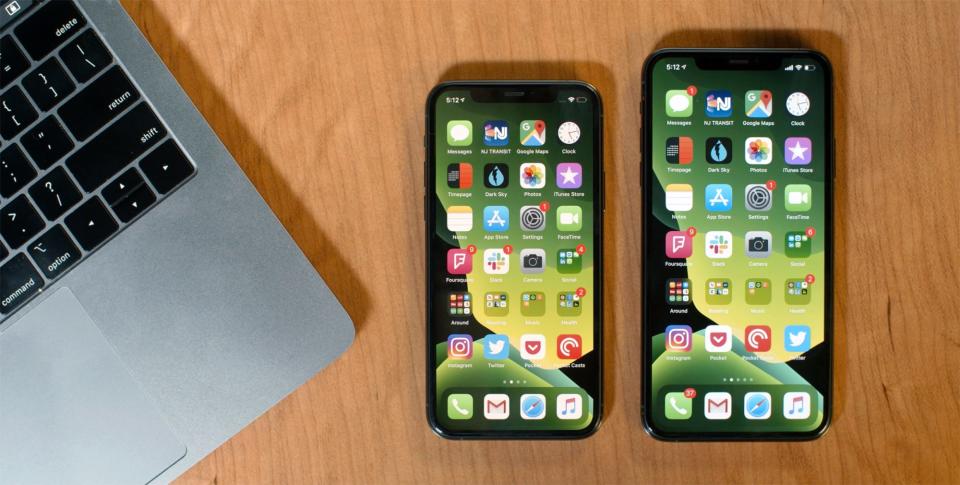
A "Super" display?
Remember when I made that crack about the fact that some iPhone Pro's enhancements were so subtle they were easy to miss? (You should — it was just a few paragraphs ago.) That starts to become clear when you consider the new Super Retina XDR display Apple used here. The smaller Pro measures 5.8 inches, while Apple used a 6.5-inch panel in the Pro Max. For the tape, these updated screens are exactly the same size and resolution as the ones we got in the XS series last year. If you were hoping for a Note 10-style redesign ushering in bigger screens and smaller bezels, you'll be disappointed.
You'd expect displays with such grandiose names to pack some noticeable improvements, but, you'd be wrong. The screens Apple used here are beautiful — I just wouldn't say they're noticeably better than the ones we already had. Compared to the XS and XS Max, the Pros have an ever-so-slightly warmer tone out of the box. This arguably becomes less of an issue when you're using True Tone, a feature that dynamically changes your screen's temperature depending on the level of ambient light around you. Still, when doing direct photo comparisons between the XS and the Pro, I often found myself preferring the way the older screens reproduced colors.
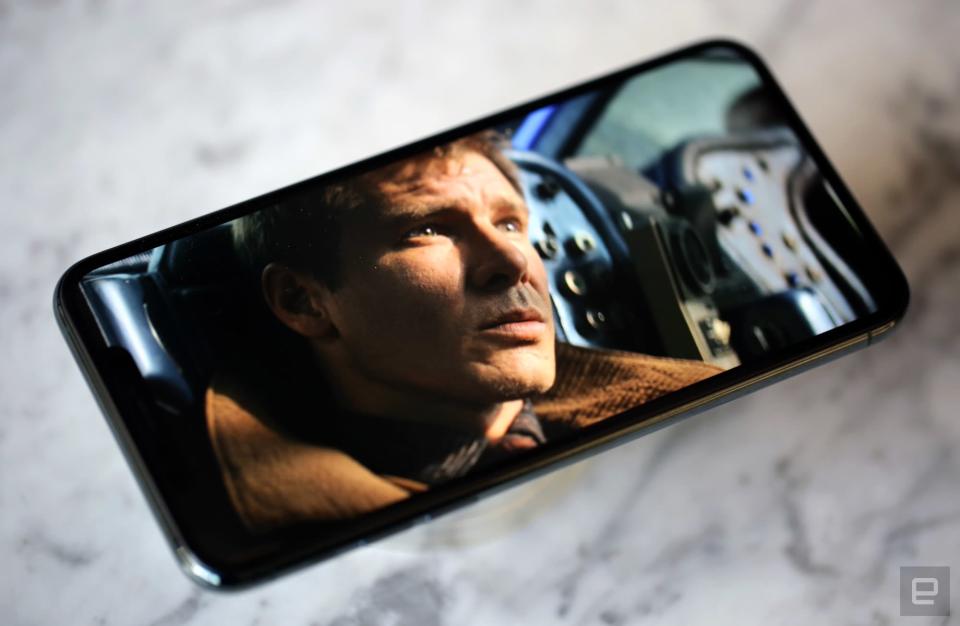
According to Apple, one of the major benefits of these Super Retina XDR displays is improved brightness — indoors, it tops out at 800 nits (compared to the mid-600s you'd get out of an iPhone XS), and it maxes out at 1,200 nits when you're watching HDR videos. That might be true, but again, good luck trying to spot the difference in real life. To properly test things, I locked myself in a dark room for several hours jumping between different 4K HDR movies downloaded from the iTunes Store. (I'd have done the same in YouTube since I spend a lot of time there, but for some reason, the app running on the Pro never offered the HDR video options it did when running on the XS Max. Weird.) The Pros' screens were, in fact, a bit brighter at times when the situation called for it, but I don't think you'd notice the difference unless you had the two phones sitting side by side.
It probably also goes without saying that these Pro screens look significantly better than the Liquid Retina display used in the standard iPhone 11 — they're sharper and more vivid, and they're capable of the deep blacks that make iOS 13's dark mode really pop. It's possible that the value of Apple's Super Retina XDR display tech will become more apparent in time, but for now, at least, they're great screens — just not game-changing ones.
It's also worth pointing out that Apple finally got rid of 3D Touch, the pressure-sensing screen technology it's been pushing since the days of the iPhone 6S. Now, I'll admit it: I actually found 3D Touch really helpful, if for no other reason than it made moving my cursor around easier after I inevitably typo'd in an email. You can still do things like access shortcuts to specific actions inside an app by long-pressing its homescreen icon, just like you could on the iPhone XR. This "haptic touch" approach isn't nearly as good as 3D Touch was, but since hardly anyone ever seemed to use it, the omission had to happen eventually.
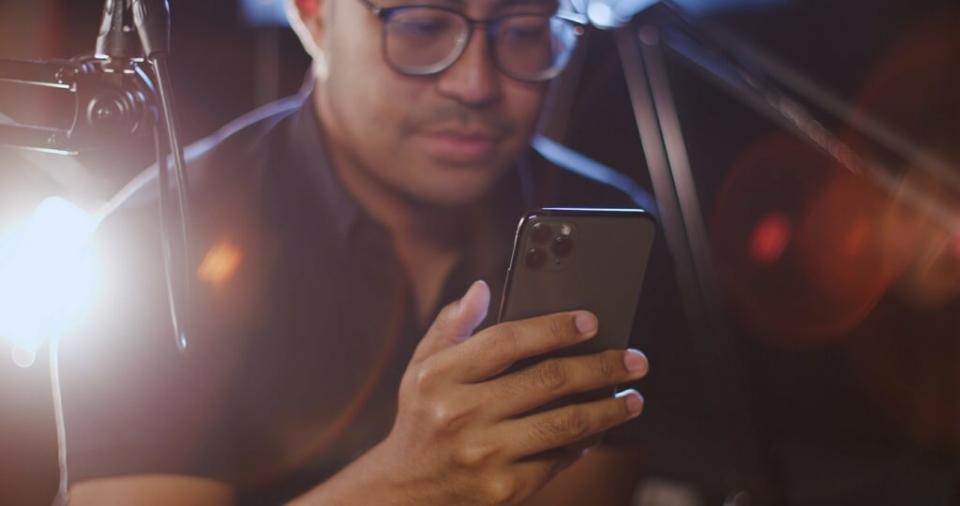
In use
Don't let the name fool you: You don't need to be a pro of any sort to use these new phones. If you've picked up an iPhone since the X launched two years ago, you'll know almost exactly what to expect. I say "almost" because a lot of what's new about the experience here is thanks to the iOS 13 update, a substantial bit of software I'll review more thoroughly once I'm done with all these dang phones.
There are a couple of neat things worth highlighting here, though: iOS's dark mode is finally here, and it looks great on the iPhone 11 Pros' OLED screens. Apple Maps has received some serious improvements, and I've been using it a lot as I drive around California. In the old days, this would've driven me crazy, but it's actually pretty great now. (The best part: When you're using Apple Maps navigation through CarPlay, Siri will tell you to make turns "after the next light.") Meanwhile, the updated Photos app lumps your pictures into a big, algorithmically curated grid that highlights certain photos it thinks you might like. Even selecting and editing text (like this review) is easier now, thanks to a handful of new multitouch gestures.
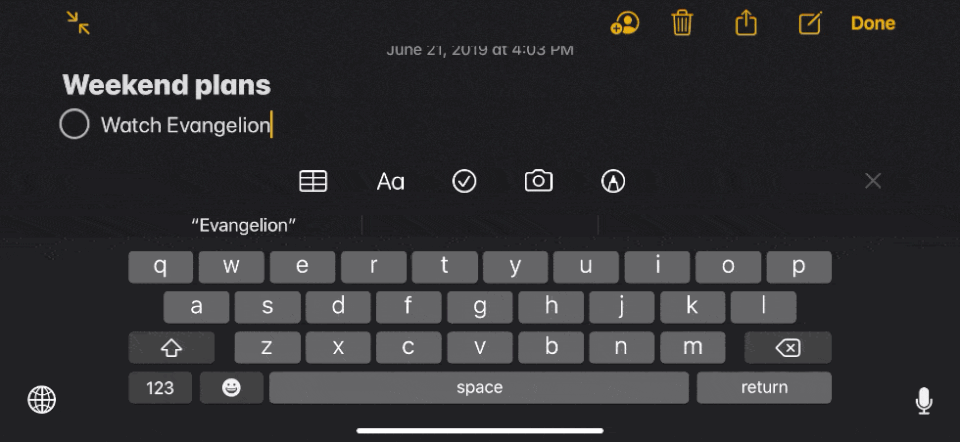
I wouldn't say my experience with iOS 13 on the Pros has been flawless, though. Sometimes when I'd try to turn on the Pro's flashlight from the lock screen, the on-screen toggle changed appearance to indicate it worked, even though the LED around back never actually turned on.
Also, certain apps, like Instagram and Prisma, don't correctly respect the bounds of the display. The former would truncate the tops and sides of people's Stories, while the latter had some icons that were clipped by the screen's notch. I'd expect hiccups like this if the Pro or the Max used different-size screens than usual, but they're exactly the same as last year. I've also been using the iOS 13 beta on the XS and XS Max for months, and this issue never popped up on my other test devices. Fixes will be dispatched soon enough, I'm sure, but it made for a stranger iPhone review experience than I'm used to.
Less strange were the improvements Apple has made to Face ID in the Pro series. It now seems to work slightly faster and doesn't falter as much as the XS Max's sensor did when I was smoking a cigarette or coming in from an angle while trying to unlock my phone. The speakers are slightly better this time, too. They're not noticeably louder, but they seem to do a better job of separating the left and right channels of whatever audio you're listening to. The result: music and videos that sound just a little more immersive.
I know why you're here, though: You probably want to know about how well these phones run. Every year, Apple unveils a new A-series chipset for its iPhones, and every year, the company talks a big game about how fast they are. During the company's iPhone keynote last week, execs even pointed out how much more powerful its new A13 Bionic was than its competitors -- the Snapdragon 855 and Huawei's Kirin 980 chip -- and last year's A12 chipset.
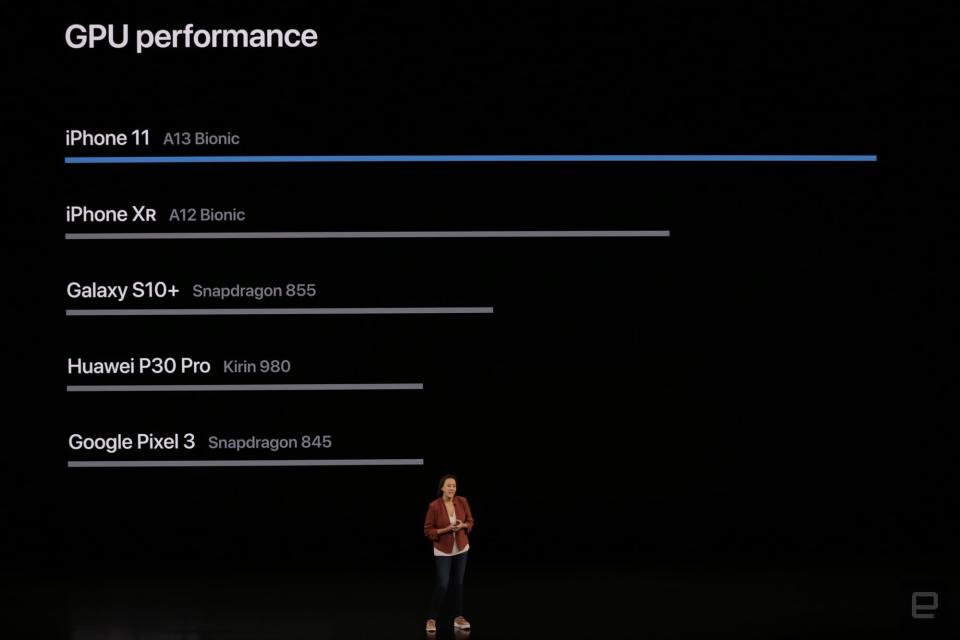
I only bring this up because, in general, Apple avoids name-checking its rivals. (When I spoke to Phil Schiller about the iPhone XR last year, he told me he didn't spend much time "thinking about the other guys." Clearly, that's not true of others on his team.) With the A13, Apple is trying to push even further past its competitors, but how potent this chipset seems really depends on what you're already used to.
If you're currently using an iPhone that's a few years old, you'll get some modern benefits just by updating to iOS 13. (Apple's update is compatible with devices as old as the iPhone 6S.) The gulf in performance between the Pros and anything older than an iPhone X is staggering, and just about everything you do happens almost immediately. Suffice to say, if you're upgrading, the Pro won't leave you wanting for power in the slightest. And if you're the type to put faith in benchmarks, the iPhone 11 Pro series holds up very well against the competition:
iPhone 11 | iPhone 11 Pro | Galaxy Note 10 | Pixel 3XL | Huawei P30 Pro | |
|---|---|---|---|---|---|
Geekbench 5 CPU (Single-Core) | 1334 | 1332 | 723 | 502 | 676 |
Geekbench 5 CPU (Multi-Core) | 3449 | 3417 | 2624 | 1951 | 2395 |
Geekbench 5 Compute (Metal and Vulkan) | 6285 | 6348 | 2143 | 626 | 1776 |
To get a sense of what the iPhone Pros are really capable of, I pitted them against last year's flagship iPhone XS series. The A12 Bionic chips inside those older phones are no slouch, and as I noted in my review at the time, they offer enough power that you don't really need to worry about upgrading for a while. As I expected, the Pros are the faster machines, but whether you'll actually notice a difference without looking is doubtful.
In day-to-day use, launching apps feels a touch quicker on the Pros than on the XS models, and while I didn't notice any significant difference in game performance, those graphically demanding apps loaded slightly faster and ran without hiccups on the Pros. If you weren't specifically hunting for improvements over earlier expensive iPhones, you might easily miss these subtle speed changes.
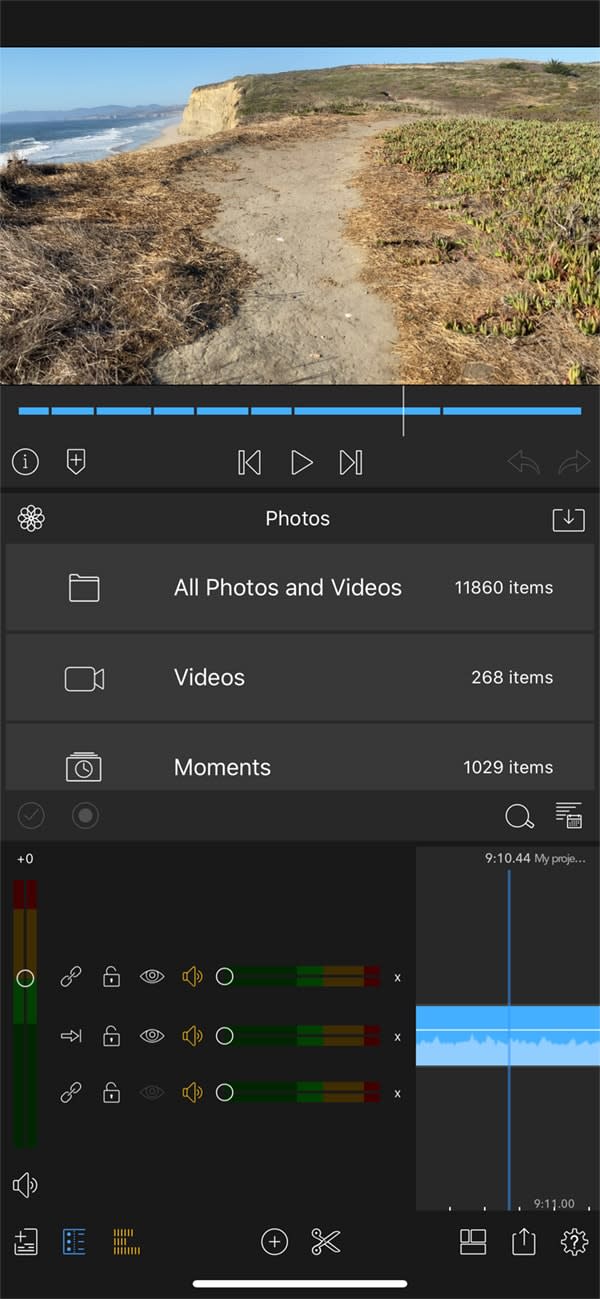
Since Apple was keen to talk about the iPhone Pros as tools for creators and filmmakers, I wanted to see if the A13 made any difference when editing and exporting videos. The test: Stringing together about 13 minutes of 4K, 60FPS footage in Adobe Premiere Rush and seeing how long it would take the phones to spit out a finished product. To be clear, this task is a little absurd for a smartphone: The resulting file would've been about 5.7GB, and not even the Engadget video team churns out 4K files that run that long most of the time. Still, this is an iPhone Pro, right? Someone had to try it. Turns out, that was enough raw footage to choke Premiere Rush entirely — the app crashed during three attempts — so I had to move on.
Take two: All that footage arranged in LumaFusion took 31 minutes and 47 seconds to spit out a properly rendered file. That was faster than the same task performed on the iPhone XS Max... but only by 20 seconds. Just to be sure, I tried exporting the same 4K footage using iMovie instead, and both phones were significantly faster. Still, the difference wasn't massive: The Pros completed the 4K export in about 18 minutes, while last year's XS and XS Max took an extra two-and-a-half to three minutes. Faster, sure, but maybe not fast enough to warrant dropping another $1,000.
Apple also put a lot of work into updating the neural engine on the A13, which might not be terribly important for a lot of you right now. I'd be surprised if you used more than a handful of machine learning-optimized apps on a regular basis. As more developers begin to build machine-learning models into their apps, these under-the-hood advances in AI processing will grow even more valuable. Generally speaking, if you use apps that rely on features like complex image recognition and applying visual filters to moving objects, you'll notice the difference immediately. In Prisma, an app that tweaks photos to embrace different artistic styles, the iPhone Pros were consistently much faster than the XS line.
The Pros take the lead when it comes to augmented-reality apps, too, like Angry Birds AR: Isle of Pigs. Not only were the Pros slightly faster at recognizing flat surfaces in front of me, they also let me walk around and change my view of the virtual much more smoothly than on the XS. The game ran fine on both, but the Pro's extra power made the elements on-screen feel a bit more like they were real-world objects, not just assets rendered on a display.
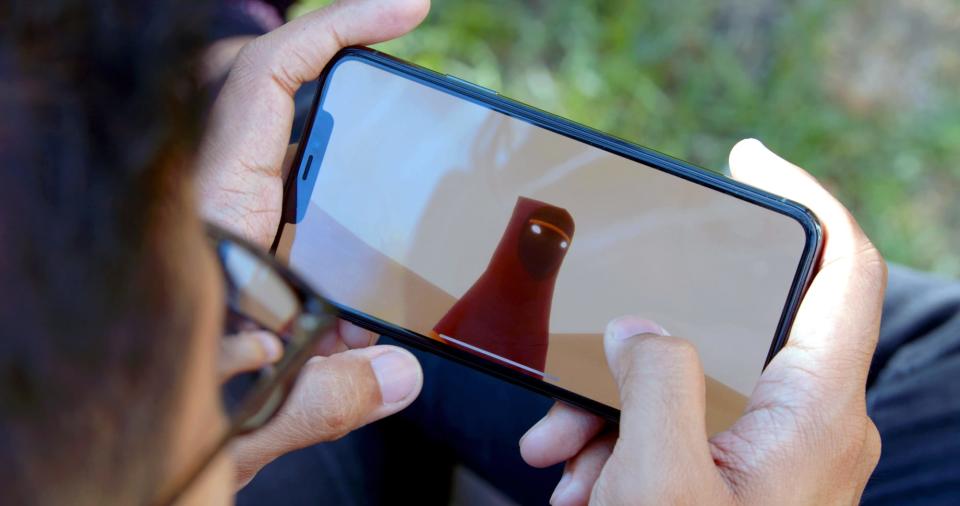
Normally, this is where I'd say that the level of CPU and GPU power offered by the A13 Bionic is a way to help future-proof these devices; if you buy one, you wouldn't need to splurge on another phone for years. That's true to an extent. These are likely to be the last iPhones Apple makes without support for superfast 5G networks, and their absence here makes some sense; pockets of the US that have 5G are few and far between, and it'll be a while yet before Apple has the ability to make one version of the iPhone that supports all the different approaches US wireless carriers have embraced. If you really want to make sure you won't have to buy another phone for a long time, it might be worth waiting.
If your current phone's battery has seen better days, though, the Pros might be worth the splurge now. So far, Apple's claims of significantly improved battery seem spot on. When I tested the brand-new XS last year, it would run for between 9 to 9.5 hours off a single charge on days with heavy use. This year, the smaller Pro dealt with the same general workloads and lasted for closer to 12 hours before needing a charge. The larger Pro Max, meanwhile, routinely stuck around for between 13 to 14 hours on a single charge, compared to the 11 to 12 hours I squeezed out of the iPhone XS Max.
Even better, Apple finally decided to ship the iPhone 11 Pros with its faster 18W USB-C chargers. Sure, I would've rather a full-on USB-C iPhone, but the move is appreciated: leaving a Pro plugged in for 30 minutes is enough to fill it up with an additional 35 to 50 percent charge.
Oh, and we need to talk about that rumor that suggested that the iPhone 11 Pros contained the hardware needed for bi-direction wireless charging — that is, the ability to charge devices like AirPods directly from the iPhone itself. Apple unequivocally said that's not true, but I suspect some of you will wait for the inevitable teardown for the final word.
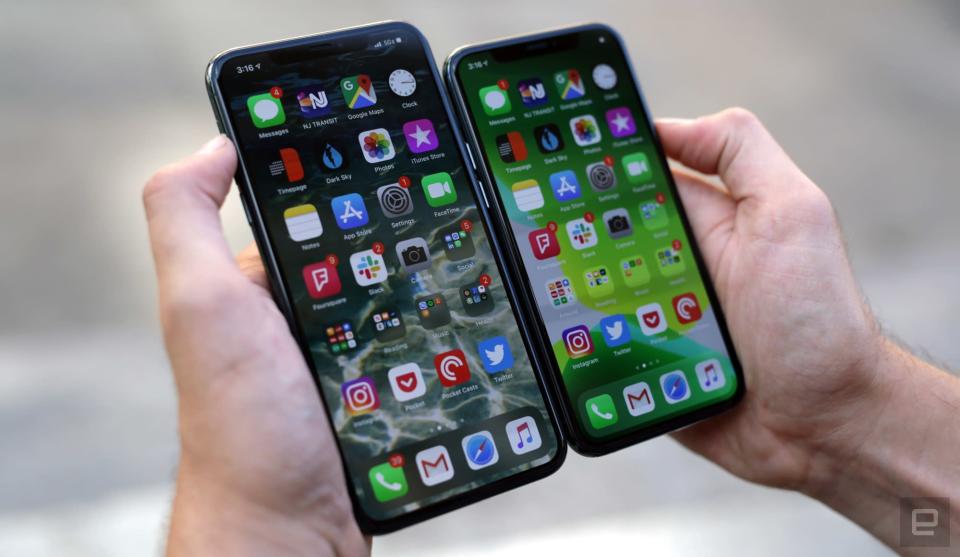
The Max difference
Just like last year, the iPhone 11 Pro and Pro Max share an underlying foundation — is there really any benefit to splurging on the Max apart from the bigger screen? Well, there's better battery life to consider, but iOS 13 doesn't bring any radical improvements to the Max's big-screen experience.
As usual, some apps and websites make full use of the Pro Max's extra screen space. Turn the Max on its side while reading the New York Times website, and you'll get three panes of news instead of just one. Some first-party apps like Mail and Messages display information and extra controls when you hold the Max sideways. That's really it, though; it's been a year since Apple introduced the Max line, and iOS 13 doesn't take advantage of these big screens any more than iOS 12 did before it. For better or worse, it's mostly identical to the smaller Pro.
Because the gap in overall performance and functionality between the Pro Max and the standard iPhone 11 is pretty minimal, I'd love to see Apple cook up new features to make this big display feel more useful. (The Galaxy Note 10+ is a great example of a device that makes interesting use of its humongous screen.) Until then, the Max seems best suited to people who need a longer-lasting device, spend a lot of time watching 4K HDR movies and always try to frame up photos just right.
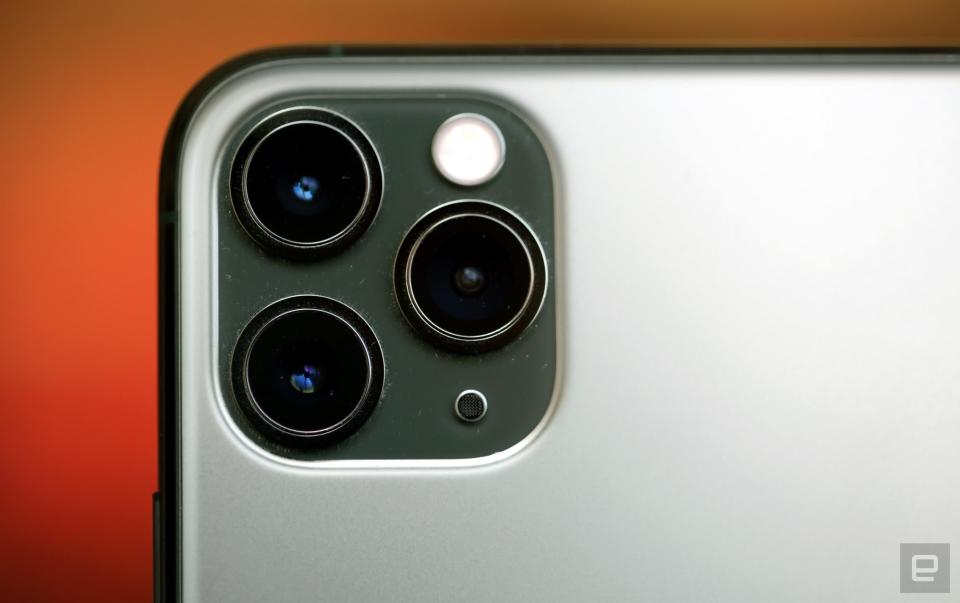
More cameras, more fun
As Google has been proving with its Pixel line, a smartphone doesn't necessarily need more cameras to produce killer photos. So why do it at all? For flexibility. Computational photography has improved to the point where you can achieve surprisingly good zoomed-in shots and low-light photos almost entirely through software. But by offering multiple cameras on a phone, companies like Apple can ensure that you have the appropriate tool for whatever situation you find yourself in.
When building the Pro and Pro Max, Apple went with these sensors:
A 12-megapixel wide-angle camera with optical image stabilization (OIS) and an f/1.8 aperture. This is the camera you'll wind up using most of the time, and the results look great.
A 12MP telephoto camera with 2x optical zoom, OIS and an f/2.0 aperture. That's slightly wider than the aperture in last year's XS telephoto camera, which makes for improved low-light performance.
A 12MP ultrawide camera with an f/2.4 aperture that captures a 120-degree field of view. This one is brand new to the iPhone Pro line, and I'm glad it's here — it's especially useful when shooting in tight spaces where you can't easily back up. It's worth noting, though, that devices like the Galaxy Note 10 capture a slightly wider field of view.
Before we get into how well these cameras work, though, we need to talk about the way they're arranged on the iPhone Pros' backs. Yes, I agree: It doesn't look great. Other companies that have built multiple cameras into their phones have generally stuck them all in a straight line, though there are a few notable exceptions. (Here's looking at you, Nokia 9 Pureview.) Apple wouldn't elaborate on why it chose this design apart from the fact that it thought it looked good, but some people I've shown it to find it downright unsettling.
The upshot here is that they take great photos.
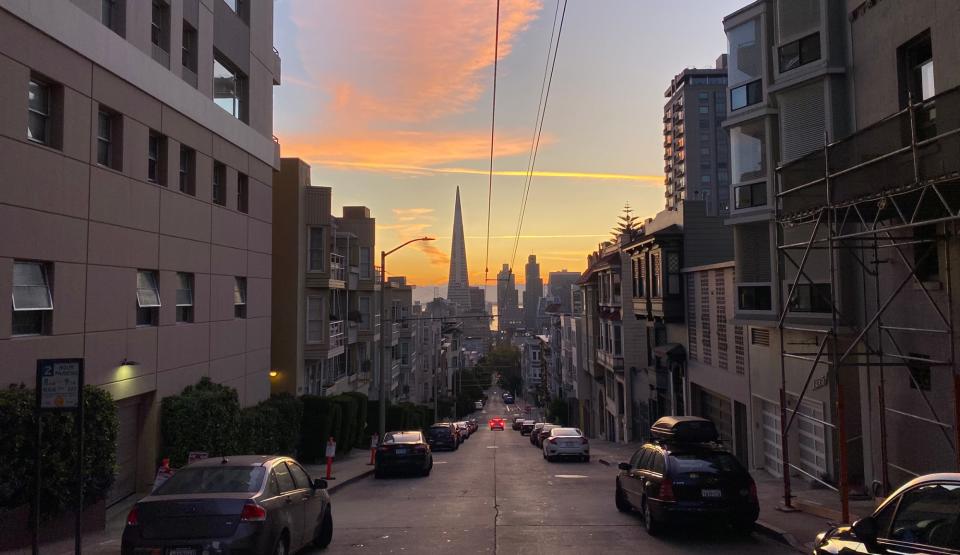
No matter which camera you shoot with, you can expect rich — though not overly rich — colors and generally solid detail throughout. The best results tend to come from that standard wide camera, though, which makes sense considering it's the one you're meant to use most of the time. The entire sensor is covered in Focus Pixels, so it's the fastest of the three cameras to lock onto your subject (especially in low light) and generally delivers the best clarity of them all too. It's easily the best all-around camera that Apple has ever squeezed into a smartphone, and it's been a blast to use.
The telephoto camera is no slouch either, and its wider aperture means it's better than last year's iPhones at providing bright photos when it's dark out. It would've been nice to see Apple push this thing past the 2x optical zoom we've had for a few years, but it's tough to argue with the results this thing is capable of.
The ultrawide camera is the newest addition here, and I've grown really fond of it. That's not to say Apple's implementation here is perfect, though. The ultrawide occasionally struggles to capture evenly exposed photos when it's dark, and it isn't nearly as good at capturing fine detail as the standard wide camera. You're probably not going to notice unless you throw these photos up onto a big screen and start pixel-peeping, though. On a phone screen, all you'll really see is the extra space and context this camera provides — that's the real draw here.
Apple also included a dedicated Night mode this year, which didn't work quite the way I expected. The camera will recognize when you're shooting in the dark and automatically enable night mode — that is, you can turn it off before you shoot, but you can't prevent it from activating in the first place. Sometimes you just want to capture the night as it is, so this proved a little annoying at times.
Unlike similar features built into Samsung and Google's cameras, Apple's approach doesn't stack multiple exposures together in hopes of turning night into day. The resulting photos are significantly brighter than shots taken without Night mode, but there's still a palpable sense that you're shooting in the wee hours. Night mode works even better if you have the Pro propped up on a tripod or a stable surface; the phone can tell that it's not moving and set its exposure time to maximum (about 30 seconds) instead of the three- or five-second exposures it defaults to when you're physically holding the phone. The only real catch here is that you can't use Night mode with the ultrawide camera at all. Personally, I prefer the way Google's year-old Pixels handle night shooting — the results are a little punchier while still retaining an appropriate sense of moodiness. Still, Apple's approach is surprisingly good for a first attempt.
The 12MP front camera isn't quite as interesting as what's around back, and as usual, it'll take serviceable selfies without much fuss. Apple did add two notable features, though: tapping a button widens the camera's field of view slightly, so you can squeeze a few more people into those shots. You can now also shoot slow-motion video with that front camera, which Apple predicts will usher in the age of the "slofie." (Expect to see these all over Instagram before long.) I don't have the sort of long flowing locks needed for truly sexy slofies, so I settled for the next best thing: Flopping my jowls around and coughing up a mouthful of sharp, star-shaped glitter. I swear, the things I do for you people.

When it comes to comparing the iPhone Pro's cameras to its competitors, it can be hard to draw significant conclusions. I spent most of my time with the Pros testing them against Samsung's Galaxy Note 10 and Google's Pixel 3XL, and the thing to keep in mind here is that when it comes to photography, each of these companies has important philosophical differences.
As usual, the cameras Apple used this year are more intent on capturing what's in front of you as accurately as possible. Samsung likes its colors punchy and its details supersharp, so its cameras often produce photos that show you a more vivid, almost idealized version of your world. Google, with its contrast-y computational photography chops, lands somewhere in between. (That could change, however, when the Pixel 4 and 4XL launch later this year.) At times, I've preferred the Pros' more neutral shots, Samsung's aggressively pretty ones, and Google's detailed, contrast-y. It all depended on what I hoped to capture with each photo.
Put another way, the photos I took with the Note 10+ are the ones I'd most like to post on Instagram with the #nofilter hashtag. The photos I shot with the iPhone 11 Pros are the ones I'd most like to throw into Lightroom and have some fun with. Which phone actually takes the "best" photos is really a matter of preference, but Apple's cameras are clever and capable enough that you won't feel like you're missing out on anything.
Shooting with these cameras will feel a little different if you're used to older iPhones, and not just because of the different focal lengths you can play with. The interface has changed, too, and it takes a little getting used to. You can still swipe left and right to change your camera mode, but swiping up on that black bar gives you access to even more controls for flash, Live Photos, timers, filters and aspect ratio. Some of these are replicated at the top of the screen because... well, I'm not really sure, but it seems unnecessary.
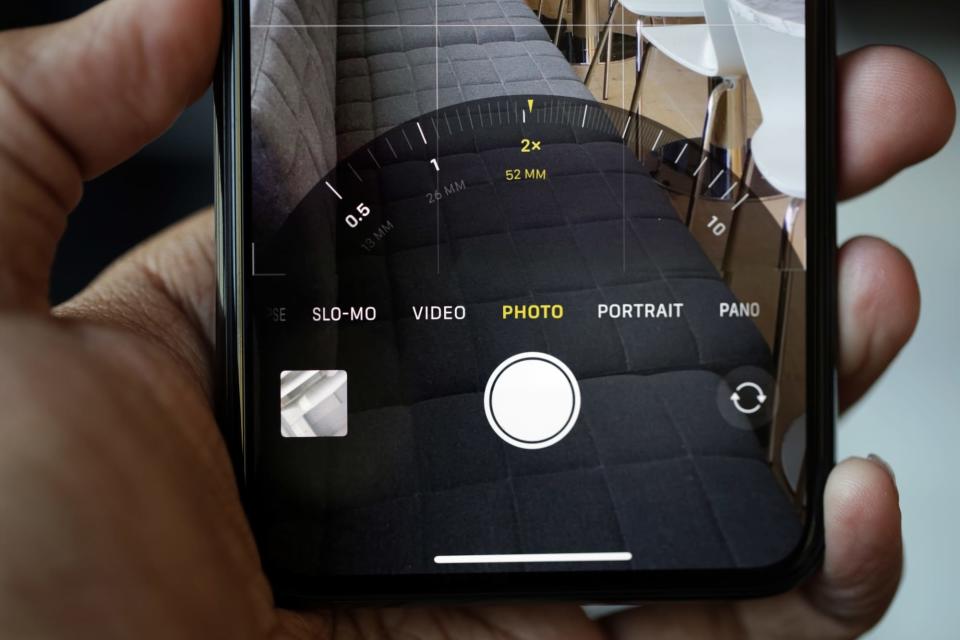
Switching between these cameras is as simple as tapping on the screen, though you can get more fine-grained control on how tight you're getting by dragging the camera selector up and down. I was a little concerned that shooting in between these different zoom ranges would introduce noise and smudge details, but the Pros did a great job making sure that wasn't the case. More impressive is how Apple reconfigured its interface to take advantage of these new camera options. When you're shooting with the wide or telephoto cameras, you'll see the rest of the scene spill over behind your shutter button and camera controls, giving you a sense of the shots you could be shooting. It's sort of like shooting with a rangefinder camera, if you're familiar with those.
There are a few other additions worth pointing out: Quicktake lets you easily switch from framing up a photo to shooting a video by holding the shutter button down. (You now activate Burst mode by swiping that button to the left.) There's also a new High Key Light Mono setting for the Portrait mode, which snaps a black-and-white headshot of your subject with a bone-white background. (Think of it as the opposite of Stage Light Mono, which drowns your backgrounds in black.) If you can ensure no one else is near your subject, the results can be pretty striking, but because the cameras are designed to search for people, you might occasionally see a stray face cluttering up your shot.
I also find it a little shortsighted that the iPhone Pros' camera lacks any kind of dedicated "pro" controls. Think: shutter speed, ISO and especially manual focus.
Most people probably won't miss them, but I sometimes did. Case in point: I spent a day shooting sample photos at beaches and trails along California's Pacific Coast Highway, where I snapped a photo of a couple, silhouetted in black, framed nicely by clumps of beach grass. The photo turned out pretty good, but in that moment, I wished I had another phone with me — one with manual focus controls that would've let me see the couple more clearly and let the surrounding plant life fade into the rest of the scenery. Historically, Apple has been more than happy to let third-party developers build apps with that kind of functionality, but maybe it's time the company addresses that challenge itself.
Unfortunately, Apple's most important new photographic feature won't be ready for a few more weeks at least. Deep Fusion promises to combine nine different exposures into a single, highly detailed photo. On the surface, it sounds like Apple's attempt to unseat Google as the king of computational photography. If it's as impressive as Apple claims, Deep Fusion could change the experience of shooting with the iPhone Pros entirely, so I'll update this review once this feature goes live.
As much as I've enjoyed using these new cameras, my time testing them hasn't been bug-free. Every once in a while, the cameras would simply fail to start up; I'd see the full slew of camera controls, but not a hint of what was in front of me. An Apple spokesperson said the company was aware of the issue and that it would be fixed in the iOS 13.1 update going live September 30th. It's nice that there's a fix on the way, but it could still lead to an annoying 10 days for people who preordered their iPhones.
My larger takeaway is that these are the best cameras Apple has used in an iPhone, and the flexibility they offer is something everyone can appreciate. Still, when it comes to performance and overall visual deliciousness, the race between Apple and its competition is still much tighter than the company would like to admit.
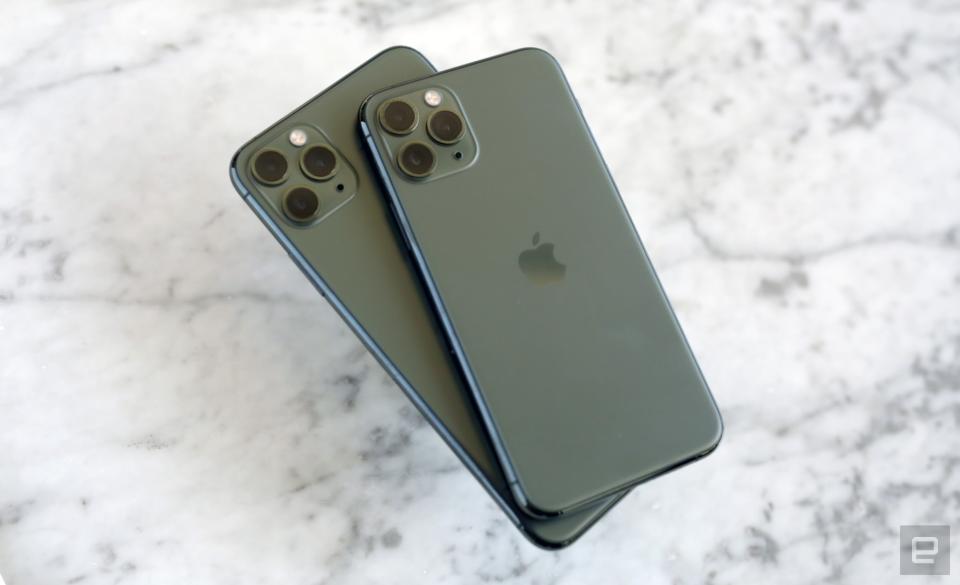
What comes next?
That Deep Fusion feature isn't the only thing iPhone 11 Pro owners have to look forward to. Most people haven't even used iOS 13 yet, but the company also plans to release another update — iOS 13.1 — ten days after the iPhone 11 line officially goes on sale. Among other things, it'll pack bug fixes for some of the issues I mentioned earlier, like the camera and flashlight not launching correctly when asked. More importantly, that update will also bring an updated version of AirDrop to the iPhone 11s; you'll apparently be able to use the currently dormant U1 ultra-wide band chip to share files with other 11 owners just by pointing your phone at them.
That sounds pretty wild, and we're looking forward to testing the feature, but let's get one thing clear: AirDrop is just the beginning. Ultra-wideband chips like these are known for their low energy consumption and precision tracking, so they'll almost certainly play nice with the Bluetooth tracker tags Apple has been working on. Beyond that, patents exist that describe how chips like these could be used to start a car by pointing at it. Since Apple is among the first major players to embrace these ultra Wideband chips at scale, it's hard to gauge how big a deal these things will be, but here's hoping we won't have to wait long to find out.
Wrap-up
The iPhone 11 Pro and Pro Max offer the best that Apple is capable of right now, but we're still left with an important question: Do you actually need everything on offer here? Certain changes, like improved battery life and the more flexible triple cameras, are updates everyone can enjoy. For almost everything else, though, the differences in actual day-to-day use can be so subtle that you'd be hard-pressed to really notice them.
Make no mistake: The iPhone Pros are better all-around compared to the XS series and are among the most powerful smartphones money can buy right now. But if you don't need the best of the best, or still aren't thrilled about the idea of dropping $1,000 on a phone -- even if it'll last you for years -- the iPhone 11 is probably the smarter choice.

